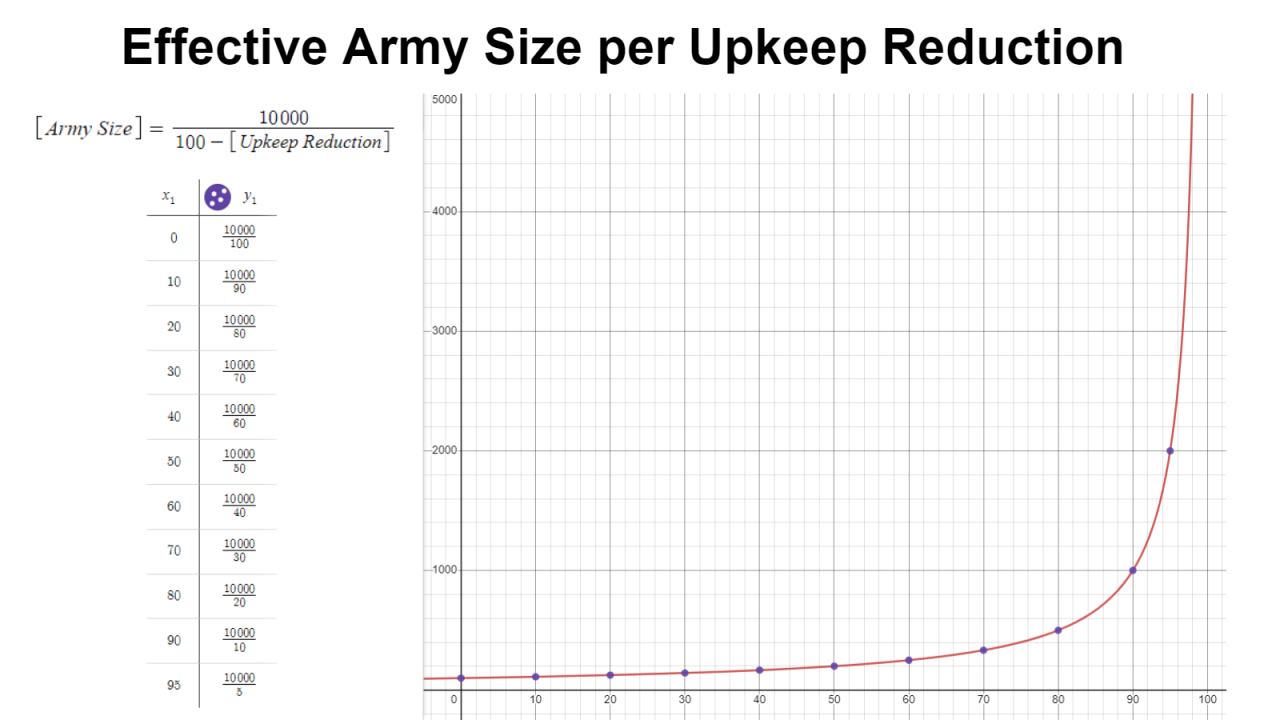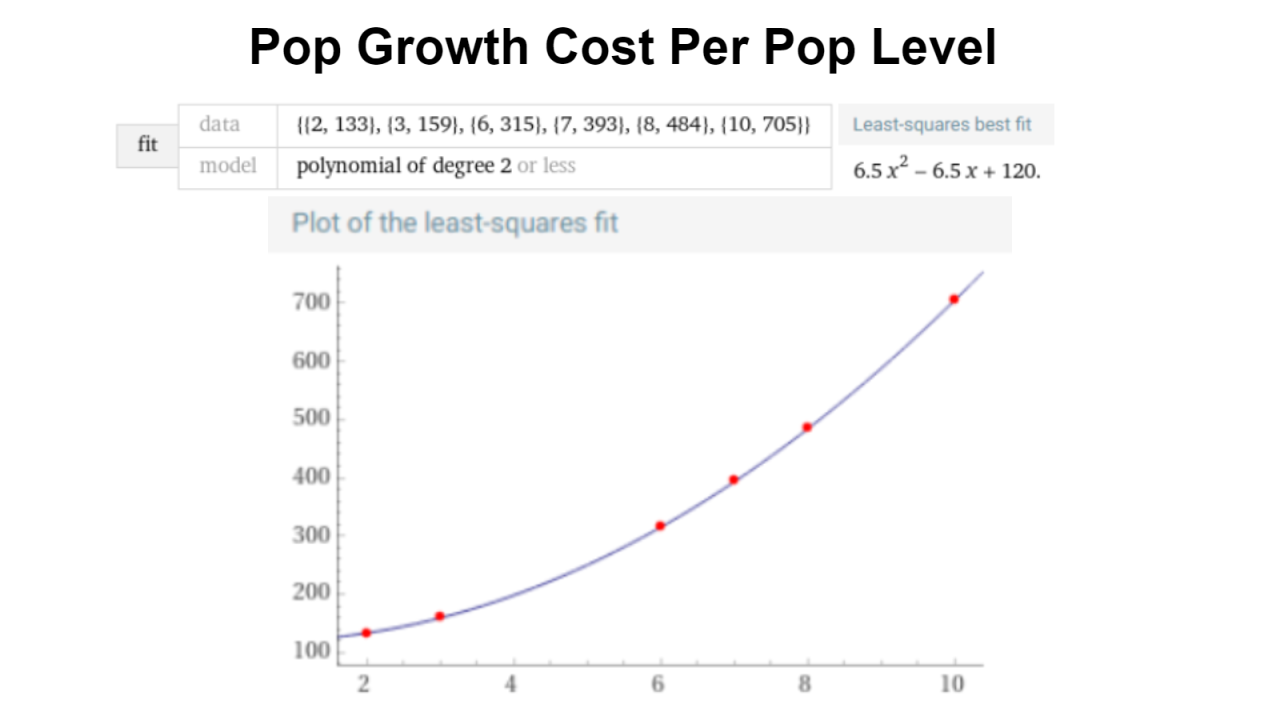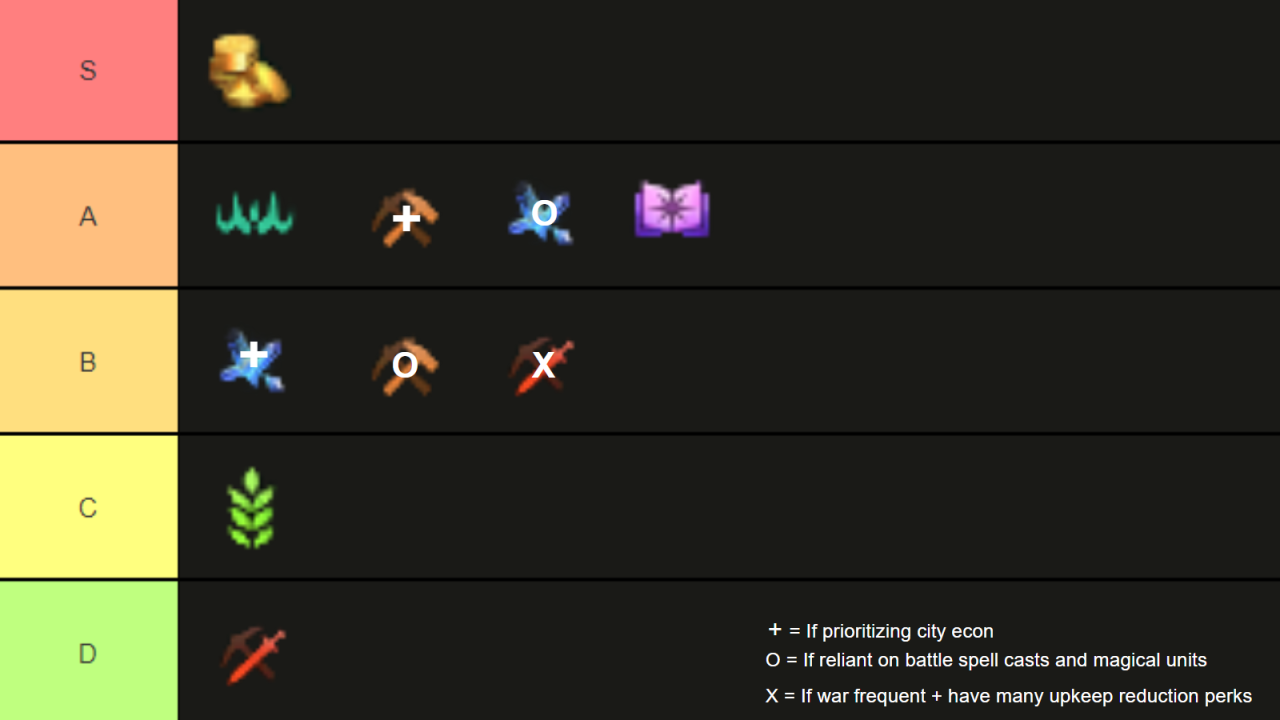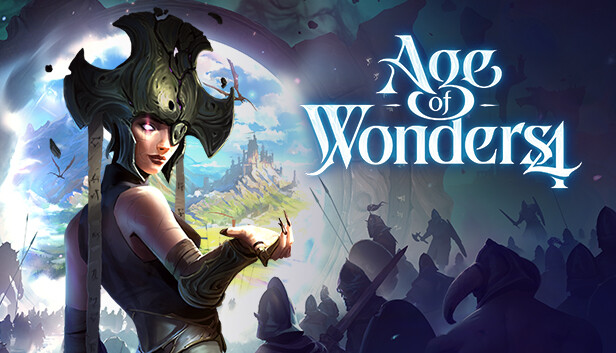For Age of Wonders 4 players, this guide will show you details of the seven different resources and a resource tier list as well, let’s check it out.
Intro
As we all know, cities are generally our main source of income.
There are 7 main types of resources that a city produces. They are:
Food
Production
Draft
Gold
Mana
Knowledge
Imperium
While gold, production, food, Imperium and occasionally mana are used for city development, gold, mana, and draft are used for unit production. Gold, mana, and Imperium are also consumed every turn for unit upkeep.
In the next 7 parts, I will be presenting details for each resource in the order of their general importance. It is to note that some resource’s importance can vary depending on your build. The first two sections will be regarding gold and imperium.
Gold
It is generally recommended to avoid queuing more than one building or unit as the gold spent for the items in the queue does not provide any benefit, and can be needed elsewhere.
————————————————————————–
Each unit generally consumes a sizable upkeep, with:
Tier I upkeep at 8g per turn,
Tier II at 12g,
Tier III at 20g,
Tier IV at 30g,
Tier V at 60g,
Meanwhile a single goldmine without any perks will only produce 5g.
As we can see, income of gold serves as a limitation for normal unit army size, and overspending of gold on unit production and upkeep can halt the development of cities.
As a result, perks that reduce upkeep can be quite powerful, as they allow you to host a much larger size army with the same upkeep.
Here is a graph of effective army size as upkeep reduces

As we can see, the effective army size increases inversely as upkeep decreases, approaching infinity as upkeep decreases to zero.
Regardless, it is important for most non-war oriented builds to not host an oversized normal unit military as the high upkeep will cripple the gold supply, halting your economic growth and putting you in an economic and research disadvantage in the mid late game. Don’t be afraid to dismiss units if they are no longer needed.
————————————————————————–
In addition to normal city development, available gold can be spent to recruit normal units through the Rally of Lieges.
Since units obtained through the Liege list do not cost draft, and generally cost less in gold to recruit compared to building similar tier units in the city, it is recommended to acquire units through the Rally list should there be no specification for the unit in need.
(Chart to compare gold and production cost for recruiting vs rally)
Units available in the Rally list depend on the player’s relation to free cities, in addition to wonders that players have captured. While units from Rally of Lieges may not be available to all players in the early game without Wonder Architects Trait, it becomes more relevant as players annex wonders and gain free cities starting around early-mid game.
————————————————————————–
Gold could also be spent on building outposts. Since upkeep for each outpost is 10 gold, outposts in a province with a gold node have no upkeep. Outposts cannot benefit from food, production, or draft, but will be able to benefit from gold, research, and mana. They can also be used to capture magic resources and ancient wonders far away from your cities, potentially overshadowing the need for regular provinces. Since units can only heal in friendly provinces without any perks or spells, outposts can also serve as a recovery location for units.
Outposts can also develop stone walls or work camps at the cost of gold, allowing you to improve defense on your outpost or annex more tiles for magic materials/wonders. This can also be used to prepare an outpost for city development, as it is a cost efficient and quick way to build stone walls or gain a population for a new city.
————————————————————————–
Abundance of gold can be used to rush buildings or units if needed at a 2 gold to 1 production or draft ratio. This exchange rate can be improved by buildings such as Luxury Markets.
These options can make a player more adaptive as being able to rush units and buildings provides the player with more options to respond to bad situations.
————————————————————————–
Gold is also spent in sieges. Siege projects can provide the attacker with unparalleled edge in this uphill battle. Most of them cannot be made possible without gold or mana.
————————————————————————–
In summary, gold is the most valuable resource as it is required for city/economic development, unit production, and upkeep. Its income determines the limits of your army size, and ability to develop your economy.
Moreover, gold can sometimes replace the need of draft by supplementing your army with cost effective units through Rally of Lieges post early game.
Having an abundance of gold will also open up more options to respond to various challenges, such as rushing units, or initiating siege projects.
Imperium
One of the primary uses of imperium is Empire development, which is reasonably similar to civics in many other games.
Empire development can provide you with many tactically or economically significant perks that can alter the way your empire develops and plays. The perks unlocked in the empire development tree are dependent on your affinity, and will be available based on the amount of turns passed and affinity you have.
————————————————————————————
Imperium is used when absorbing captured or vassal cities into your empire.
It is also used in migrating, a process where you absorb a city but replace the original city race with your own. Moreover, imperium is also necessary to convert outposts into cities and increase your city cap.
It is generally recommended to capture/build new cities early and near wonders to fully utilize your city cap, as each city is a powerhouse for your economy. Avoid going above city cap as each city above city cap will penalize your city income by 25%.
Do note that it cost 200 Imperium to absorb, migrate, or found a new city. Raising the city cap cost 200 imperium for the first time, and increases by 300 for each time you raise it.
————————————————————————————
Imperium can also be used to boost allegiance gain. This is generally used to help secure vassalization of a free city from another player.
It can also be used to rush population should there be a need to annex a province quickly. It is to note that the imperium cost varies based on the amount of turns left for the next population to complete. It is fair to say that this cost reduces as the food income of a city increases.
————————————————————————————
Units that are Tier 4 or higher will also have a small imperium upkeep. Tier 4 units cost 3 imperium per unit while Tier 5 cost 7 imperium. This upkeep is generally negligible in the late game but could be significant if there are too many high tier units.
————————————————————————————
In summary, Imperium is important as it is required for obtaining game changing perks as well as building new cities, boosting your economy and combat capacity. Moreover, it is also used in securing vassalage and an abundance of imperium can be used to rush populations for province gains. In addition to gold and mana, imperium income also serves as a limit for your late game high tier army size. All of these factors make Imperium the second most important resource in the game.
For the next three parts, I will be talking about production, Knowledge, and mana, which I considered to be ranked equally.
Production
Unlike draft, cities are generally always constructing new infrastructures, and are converted into gold when no buildings are being constructed. Unlike gold mines, there are more useful perks and special improvements that synergize with quarries. Quarries are also way more abundant than mines, making them easier to group and amplify.
——————————————————————————
In summary, infrastructures are what amplifies and spearheads your empire’s economy, and should not be taken lightly. More infrastructure will make your cities happier, harder to siege, and produce more.
By stacking production, you are also preparing your cities for gold production once all infrastructures are completed. While the conversion rate is only 1 to 4, gold is extremely useful, and production is easier to specialize towards, in comparison to gold.
Knowledge is just as important, as we will see in the next section
Knowledge
Finishing about 4 spells will also allow you to unlock a new book.
Most books will also unlock a special province improvement. It is to note that each book you unlocked provides you with 5 to 10 over world and in battle casting points. It will also add onto your Affinity, which is mainly used to unlock tier 4 & 5 tomes, as well as empire development options.
————————————————————————————————
In summary, research is similar to science in most other 4x games without the necessary requirement of having high draft or production to take advantage of them, as most of the boons offered are spells and summoned units that rely on casting points and mana.
Mana
While most spells are self explanatory, spell casts in battle are limited by your battle casting points.
Each turn outside of battle, you can only use as much mana as your world map casting points. World map casting points can be seen as production but specifically for overworld spells and summoned units as long as there is mana avaliable.
Unit or City Enchantment and Summoned units also require a constant mana upkeep. Mana can also be spent in a few siege projects.
————————————————————————————————
In summary, while it is important to keep your mana gain positive for overworld and battle casting, it is also important to avoid storing too much mana as storing large quantities of mana does not benefit the caster. Large quantities of mana can be difficult to make full utilization of in a short time due to the limitation of casting points.
As mana can help buff normal units or recruit magical units into the roster, it is reasonable to keep a sizable list of enchantment or magical army to extend your military might without putting a heavy toll on your gold income.
In the last two sections, we will be detailing food and draft, which I consider to be the least important.
Food
However, the reason why food is one of the least important resources is due to its increasing food cost to gain a population as the population of a city increases.
As we can see through the following chart:

Food cost for a 6 population city to reach 7 pop is twice as much as that from 3 to 4.
While the cost for a 10 pop city to grow is double of that of a 6 population city.
On the other hand, the resource gain of each province does not depend on the city size and is more dependent on the city’s infrastructure and positioning.
Do note that each population also consumes a negligible 3 food per population.
————————————————————————————
In summary, while this resource is decently useful in new cities to promote quick province growth, its usefulness falls drastically as the city grows. Outposts can also replace some function of food without the restriction of city connection.
Draft
Moreover, its main function can be overshadowed by the rally of lieges, as rally of lieges can provide units at a lower initial gold cost with no draft cost.
It is to note that for a warring heavy empire, draft can be more important. This is especially the case if the unit upkeep is low, => losses are more common, => and excess amounts of units are more utilized for frequent wars and gains.
Moreover, there is a limitation to how many units a rally of lieges can provide every several turns and cannot replace the function of draft in those cases.
———————————————————————————
In summary, unless you are a war heavy empire, draft’s general worth is merely 1/4th that of food for a significant portion of the game.
While production is always used to construct infrastructures and grow the economy, draft is oftentimes wasted, as recruiting too many units will lead to a massive upkeep, potentially crippling your empire’s economic growth.
Conclusion

Related Posts:
- Age of Wonders 4 AI Explained
- Age of Wonders 4 Regular Province Improvement Guide
- Age of Wonders 4 Cheat List Guide
- Age of Wonders 4 Mystic Necromancers Build Guide
- Age of Wonders 4 Tome of People Crafting
